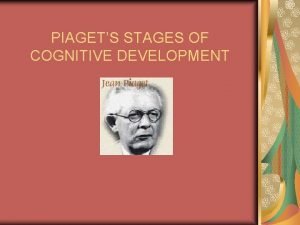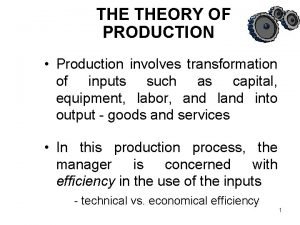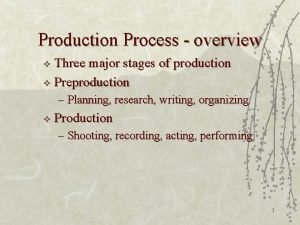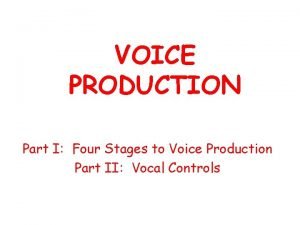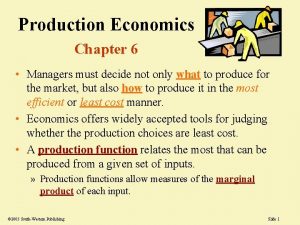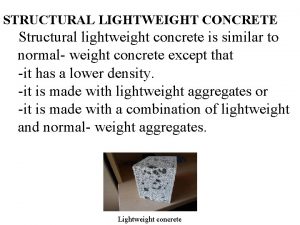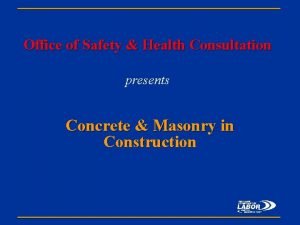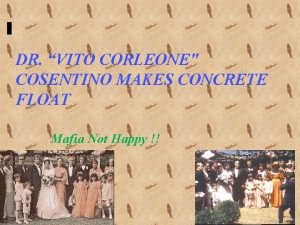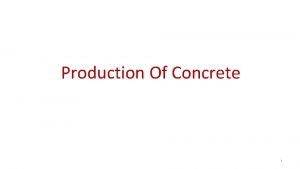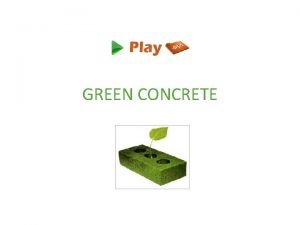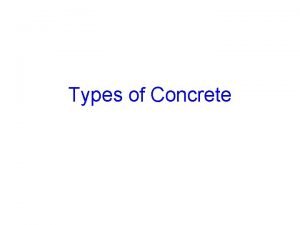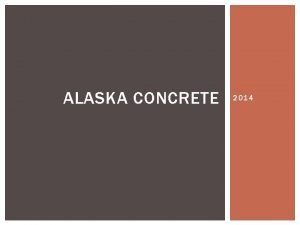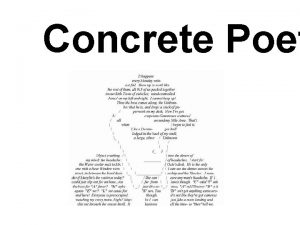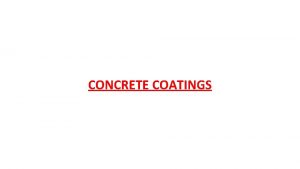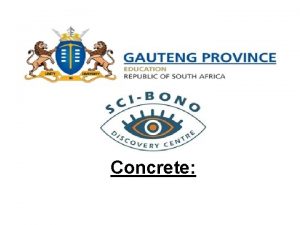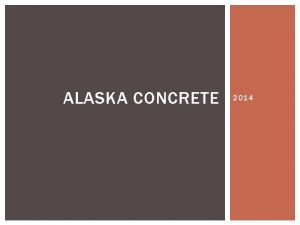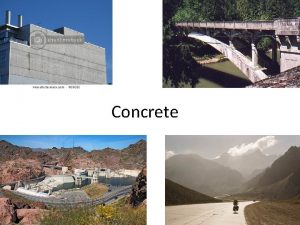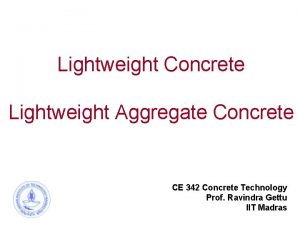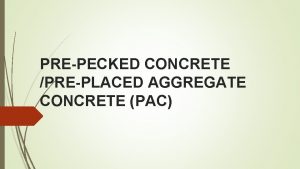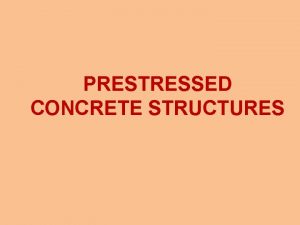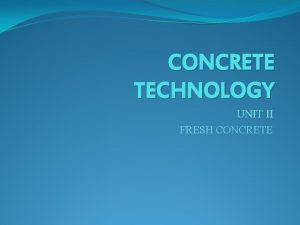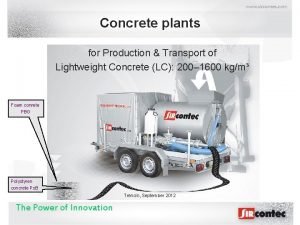Production Of Concrete 1 Production Of Concrete Stages


















- Slides: 18

Production Of Concrete 1

Production Of Concrete Stages: 1. Proportioning, 2. Mixing, 3. Transportation, 4. Placement, 5. Compaction, 6. Curing. 1. Proportioning: Should be as per design mix with minimum voids and desired strength. 2

Production Of Concrete 2. Mixing: To ensure homogeneous mass of uniform colour and consistency. Types: 1. Hand mixing, 2. Machine mixing: a) Batch mixing, b) Continuous mixing. Mixers: 1. Pan mixers: Used for stiff and cohesive mixes. 2. Drum type mixers: a. Tilting type, b. Non tilting type, c. Reversing. 3

Production Of Concrete As per IS: 1791 -1985: Tilting : 85 T, 100 T, 140 T, 200 T Non tilting : 200 NT, 280 NT, 400 NT, 800 NT, Reversing : 200 R, 280 R, 340 R, 400 R TILTING MIXER NON TILTING MIXER DRUM MIXERS REVERSING TYPE MIXER 4

Pan type Mixer

Production Of Concrete Sequence Of Charging Ingredients: 1. 2. 3. 4. 5. 6. 7. 25% of water, 50% of CA, 50% of FA, 100% of Cement, 50% of CA, 50% of FA, 75% of water. Mixing Time: Ø 25 -30 revolutions (About 2 minutes) are sufficient. Ø Mixing for longer time is desirable in case of doubt. 6

Production Of Concrete 3. Transportation: 1. The transit time should be a design parameter. 2. Method of transportation should be decided in advance for deciding suitable admixture. Methods: 1. Mortar Pan, 2. Wheel barrow or hand cart, 3. Bucket and ropeway, 4. Truck mixer and dumper, 5. Belt conveyor, 6. Chute 7

Production Of Concrete 7. Skip and hoist: Used for high rise buildings etc. 8. Pump and pipe line method: a) Most sophisticated method, b) Rate can be 8 -70 cum per hour, c) Dia. of pipe 8 -20 cm, d) Pipes of steel, aluminum or plastic are used, e) Can be used upto 300 m of horizontal and 90 m of vertical distances, f) Slump should be 40 -100 mm or 0. 90 -0. 95 CF, g) ‘Go-Devil’ special ball should be used for cleaning. 8

Production Of Concrete CONCRETE PUMP 4. Compaction: 1. Process of expelling entrapped air. 2. 1% of air reduces 6% of strength. Types: 1. Hand compaction, 2. Mechanical compaction. 9

Production Of Concrete 1. Hand Compaction: a. Rodding: 16 mm dia and 2 m long rod is used. b. Ramming: Used for PCC but not for RCC. c. Tamping: Wooden cross beam of 10 cmx 10 cm is used. 2. Mechanical Compaction: Vibrations are imparted by mechanical means resulting into temporary liquefaction and bubbles come on top and escape. 10

Production Of Concrete Types: 1. Internal vibrations 2. External vibrations 3. Table vibrations 4. Platform vibrations 5. Surface vibrations 1. Internal Vibrations: a. Most commonly used technique. b. Needle dia. varies from 25 to 75 mm and length from 25 to 90 cm. c. Frequency range is 3500 -5000 rpm. 11

Production Of Concrete 2. External Vibrations: a. To be used where internal vibrations can not be used. b. Less effective and consumes more power. c. Form work should be extra strong. 3. Table Vibration: Used in labs. 4. Platform Vibration: Used in large works, precast works such as electric poles, railway sleeper, pre cast slabs. 5. Surface Vibration: a. Also called Screed Board Vibrators. b. Action is similar to tamping. c. Not effective beyond 15 cm depth. 12

Production Of Concrete IMPORTANCE OF COMPACTION 13

Production Of Concrete Curing: Process of promoting hydration for development of strength and controlling temperature. 14

EFFECT OF CURING 15

Production Of Concrete Methods Of Curing: 1. Replenishing the lost water: a. By immersion in water, b. By ponding, c. By sprinkling, d. Using saturated jute bags etc (Mostly used method). 2. Preventing loss of moisture: a. By curing compounds: For high W/C ratio, b. By impermeable membrane coverings. 16

Production Of Concrete Important Facts About Curing: 1. Curing should be started as early as possible. 2. Concrete should have sufficient strength so that curing does not damage it. 3. Uninterrupted curing should be ensured. 4. High strength concrete should be cured at an early stage. 5. Humid climate is sufficient and curing is not required in rainy season is not correct. 6. It can not be made measurable item in contract. 7. The best way is to educate the person responsible for curing. 17

Thanks
 Post production adalah
Post production adalah Concrete semi concrete abstract
Concrete semi concrete abstract Concrete semi concrete abstract
Concrete semi concrete abstract Symbolic play piaget
Symbolic play piaget Slope of budget line or price line is
Slope of budget line or price line is The act of production involves transformation of
The act of production involves transformation of Film production
Film production Three stages of short run production function
Three stages of short run production function 3 stages of production process
3 stages of production process Laryunx
Laryunx 3 stages of production
3 stages of production Stages of movie production
Stages of movie production Didls analysis example
Didls analysis example Sulphur impregnated concrete
Sulphur impregnated concrete Concrete experience
Concrete experience Limited access zone
Limited access zone Middle ages description
Middle ages description Percentile meaning in math
Percentile meaning in math Concrete mafia
Concrete mafia



